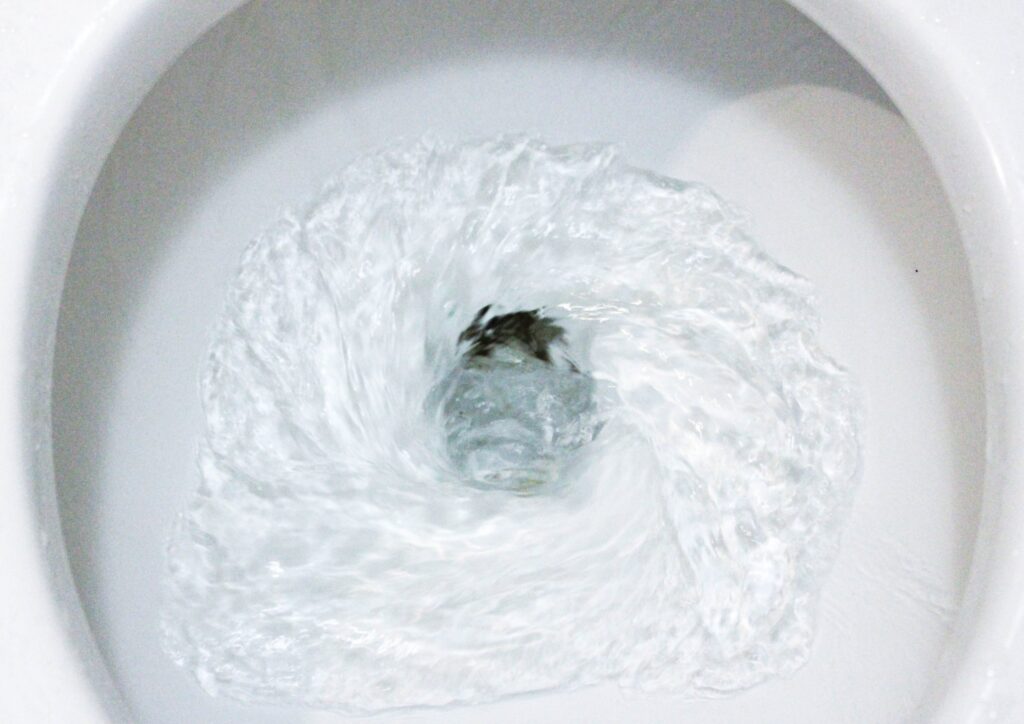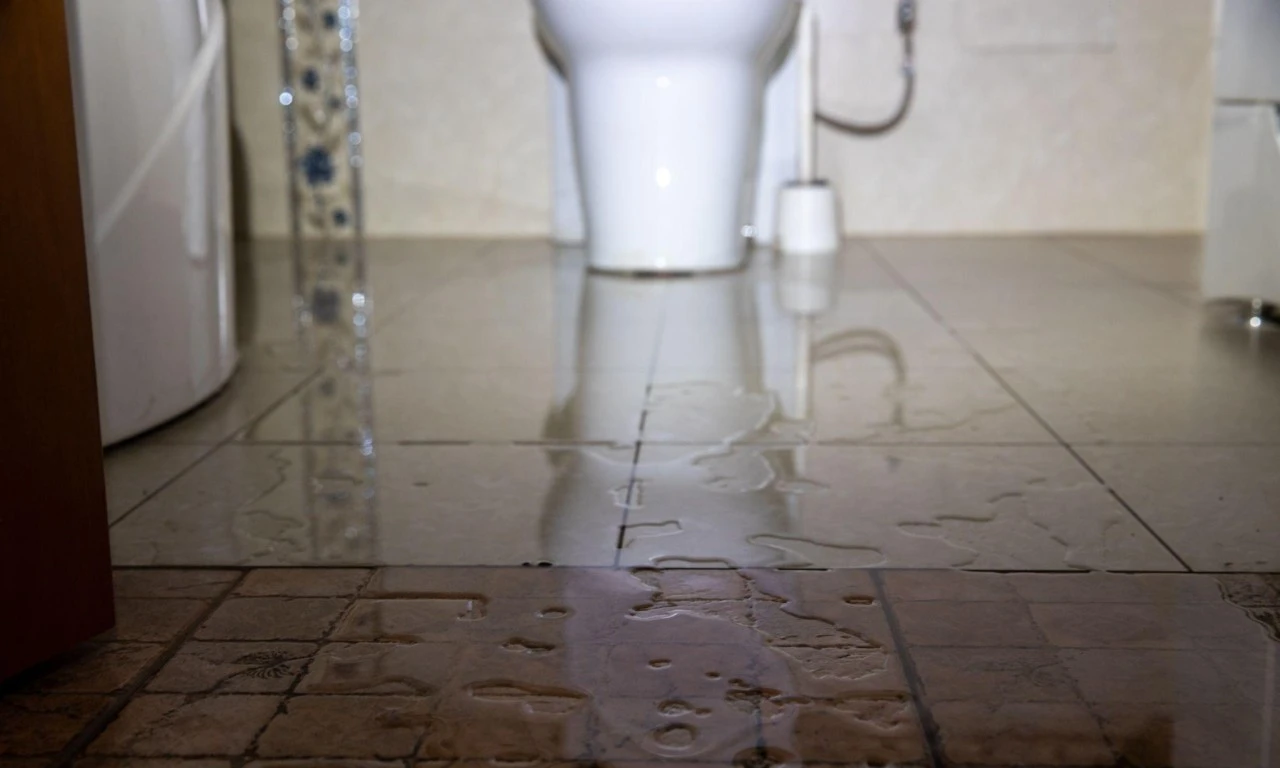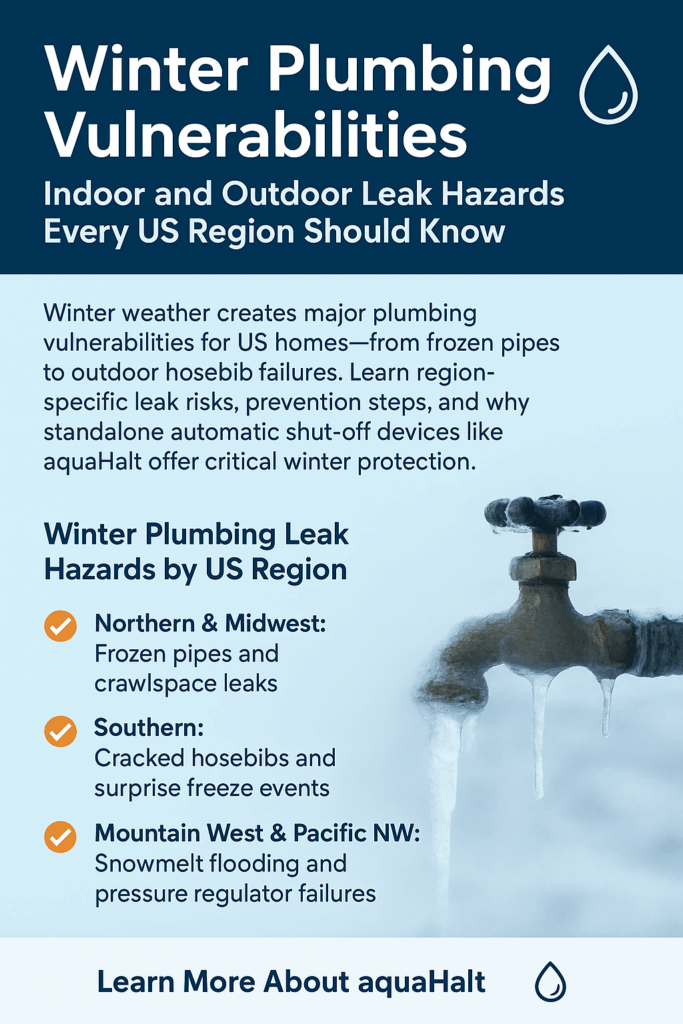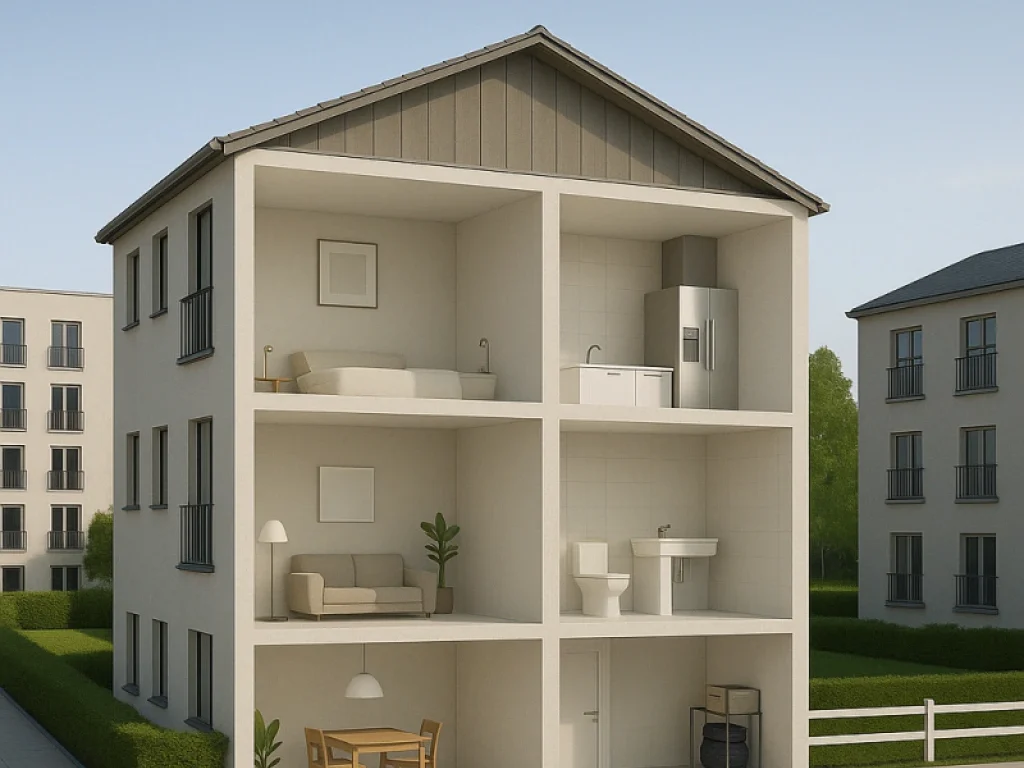
According to the United States Environmental Protection Agency, toilets are far and away the number one water user in the average home, making up nearly 30 percent of a residence’s indoor water consumption—an issue that can contribute to water damage if leaks or overflows occur. Data further indicates that outdated toilets versus newer, more efficient models can use up to six gallons of water per flush!
This can be compounded when taking into account malfunctioning or clogged toilets that can lead to overflow issues. In such cases, an ounce of prevention can save time, money, and an epic hassle when it comes to preventing toilet overflow, water waste, and home flooding. This is where patented technology by aquaHALT by waterAUTOMATION, a battery-operated leak detection system that stops water flow at the source, can make all the difference.
Multiple sites, including This Old House, report that water damage is reliably at the top of the list when it comes to common reasons people put in home insurance claims. Many people would know to expect damage from things like storms, but the responsible homeowner should also consider problems stemming from issues inside the home, including those that start with overflowing toilets. While insurance may cover the cost of some repairs, there is no way to pay back the hassle and time involved in the unpleasant cleanup and renovation process that follows an overflow.
For these reasons, and more, aquaHALT devised its innovative system to actually stop leaks, versus merely reporting that they are occurring, as other systems might do.
Did you know that homes are ten times more likely to be damaged by water leakage than fire? Ten times! On top of this, the average cost of flood damage caused by a water leak can be upwards of $11,000—a huge financial burden for most people. The affordable, easy-to-use and install aquaHALT system provides peace of mind that any such leaks stemming from malfunctioning or overflowing toilets can be stopped before those thousands upon thousands of dollars of damage can be incurred.

It’s not just individual homeowners who can benefit from this trademarked technology either. Landlords and property managers will find that this stop-at-the-source leak detection system will be a vital asset to rental spaces, allowing multiple units to be monitored at once so that a problem leak in one unit won’t overflow onto floors below or neighboring units in a given building.
Uniquely, aquaHALT requires no electrician or plumber to install the device. Rather, a user needs nothing more than two AA Batteries. Users may also want to contact their insurance carrier to let them know the user has invested in this preemptive device, as the aquaHALT system could lead to a great deal of savings for both the insurance company and the policyholder.
Just as a smoke detector alerts a resident of dangerous smoke filling a home, aquaHALT detects unusually high levels of water and moisture around the toilet. However, whereas a smoke alarm cannot put out a fire, aquaHALT can stop flowing water at its source instantly. This is of particular value to people who are away from their dwelling when problems arise. Whereas someone who is at home might be able to intervene instantly, someone who is miles away at an important meeting, work, or appointment can rest assured that a small leak won’t turn into a major flood.
What’s more, those afraid of marring any carefully curated bathroom décor don’t need to worry, as few people even notice the discreet water monitoring unit tucked away behind the toilet tank.
For these reasons and countless others, a small investment in an aquaHALT can lead to big savings down the line.
Many US homeowners are shocked to learn their insurance won’t pay for common types of water
damage. Discover what’s excluded, why claims get denied, and how simple preventive tools — like
standalone automatic shut-off devices — help close the coverage gap.
Why So Many US Homeowners Get
Blindsided by Denied Water-Damage Claims
Water damage is one of the most common and most expensive home risks in the US — yet many
homeowners believe their insurance covers any leak. It doesn’t.
The Insurance Information Institute reports that over 20% of water-damage claims are denied,
mostly for leaks that are slow, preventable, or maintenance-related.
Here’s the painful truth:
A tiny drip you didn’t see last month can easily turn into a $10,000+ repair — with zero insurance
coverage.
This is where prevention becomes more than a convenience—it becomes a financial safety net.
This guide breaks down the most common exclusions, why insurers deny claims, and how simple,
reliable prevention tools can protect you long before a leak becomes a nightmare.
Common Water-Damage Exclusions in US
Home Insurance Policies
Most US insurers separate water damage into two categories:

As temperatures drop, plumbing systems across the country come under stress in ways most homeowners never notice — until a leak becomes a flood.
According to the Insurance Information Institute (2024), winter freeze-related plumbing failures are among the top three causes of water damage claims, costing US homeowners over $11,000 per incident on average. And in regions with extended cold snaps, the financial toll is even higher.
The challenge is that many winter-related leaks are:
Slow and silent
Hidden behind walls, outdoors, or in crawlspaces
Completely preventable with the right preparation
From frozen interior pipes up north to split hosebibs in warmer states, winter reveals vulnerabilities that otherwise stay dormant all year.
This guide walks you through:
✔ Region-specific winter plumbing risks
✔ Indoor and outdoor leak hazards
✔ Practical prevention steps
✔ How automatic shutoff devices like aquaHalt protect your home — even during power and internet outages
Winter doesn’t strike every region the same way. Here’s what homeowners across the country should prepare for.
Typical states: MN, WI, MI, IL, OH, PA, NY, VT, ND, SD, MA, ME
Extended freezes and sudden temperature drops make these areas especially vulnerable to:
High-risk locations include:
Uninsulated basements
Exterior-facing walls
Garages
Attics
When water freezes, it expands — and the pressure can rupture copper, PEX, and PVC lines with ease.
In winter, furnace-attached humidifiers often drip due to:
Cracked valves
Loose fittings
Clogged drain tubes
These leaks often go unnoticed for weeks.
Add insulation sleeves to exposed pipes
Leave cabinet doors open during severe cold snaps
Disconnect and drain humidifier lines during maintenance
Place aquaHalt units under sinks, toilets, and fridge lines for automatic shutoff protection
Why aquaHalt matters here:
If a pipe bursts at 2 AM in a crawlspace or basement, aquaHalt detects the leak instantly and shuts off water at the source — no Wi-Fi, no power, no app needed.
Typical states: TX, LA, GA, SC, AL, MS, OK, AZ
Southern homes are built for heat, not cold. That’s why unexpected freezes — such as the Texas 2021 event — cause massive water damage.
Common vulnerabilities:
Non-insulated hosebibs
Exposed PVC irrigation lines
Outdoor laundry hookups
A single overnight freeze can split a spigot or crack a line behind the wall.
Many homes place water heaters, softeners, or washing machines in outdoor closets — making them highly vulnerable.
Install hosebib covers
Insulate outdoor utility closets
Drain irrigation systems
Place aquaHalt units in exterior laundry closets and washing machine hookups
Why aquaHalt matters here:
Outdoor utility closets freeze faster than indoor rooms. aquaHalt’s automatic shutoff prevents flooding even if you’re away.
Typical states: CO, UT, WY, ID, WA, OR, MT
This region’s temperature swings between freezing nights and warmer days create constant plumbing stress.
Pipes expand at night, contract during the day — a cycle that weakens plumbing over time.
Cold snaps can crack regulator valves, triggering:
Leaks at the main
Appliance hose bursts
Sudden surges in pressure
Basements and crawlspaces often take on water during late-winter melts.
Insulate all exterior piping
Test pressure regulators annually
Keep sump pumps clear
Add aquaHalt sensors to basements and under sinks
Even homes in warm climates experience winter-related plumbing issues:
Cold weather stiffens supply lines, increasing the chance of cracks.
Small drips go unnoticed more easily during winter months.
Winter strain increases the risk of tank failure and valve leaks.
Drain tubes work harder in winter — and clog more often.
Prevention:
Install aquaHalt units at high-risk indoor locations: kitchens, bathrooms, laundry rooms, and near water heaters.
These should be checked immediately:
Outdoor hosebibs
Irrigation/sprinkler systems
Pool equipment
Exterior laundry hookups
Water softener sheds
RV/auxiliary connections
Even a minor winter leak can freeze, expand, and rupture — causing severe structural damage.
Kitchen sinks
Bathroom sinks
Behind toilets
Laundry machines
Water heaters
Furnace humidifiers
Hosebibs
Exterior utility closets
Crawlspace entry points
Softener sheds
Why aquaHalt is ideal for winter:
If the internet drops, the power goes out, or a freeze shuts down your router — aquaHalt continues working, sounding a local alarm and shutting off water instantly.
Winter plumbing failures are expensive, disruptive, and often invisible until the damage is extensive. But with the right preparation — and the right protection — they’re far easier to prevent than repair.
Insulate exposed pipes
Cover and drain hosebibs
Inspect appliance supply lines
Check furnace humidifier tubing
Install automatic shutoff devices like aquaHalt
If you want a leak protection system that works even during:
✔ Power outages
✔ Internet outages
✔ Router failures
✔ Severe freeze events
Then aquaHalt offers the reliability you need — fully standalone, fully automatic, with a local alarm and immediate shutoff.

For years, homeowners have trusted simple float switches and drip sensors to warn them of water leaks. These devices were better than nothing — until you realize their biggest flaw: they only alert you after water has already escaped.
According to the Insurance Information Institute (2024), the average water-damage claim in the United States exceeds $11,000 per incident, with burst hoses, leaking valves, and failed water heaters among the most common causes.
The problem is simple — traditional alarms can’t act, they can only react.
Traditional leak detectors often:
⚠️ Alert you after the damage begins
🔌 Rely on power or Wi-Fi, losing function during outages
🧍♂️ Require manual intervention to shut off the water
So even though they “work,” they don’t truly protect.
Today’s modern systems go far beyond beeps and blinking lights. The newest generation of smart leak detection systems can automatically sense abnormal water flow, trigger alerts, and — most importantly — shut off the water instantly.
These systems combine:
Real-time flow monitoring
Automatic shutoff valves
Audible or connected alerts
But here’s the twist: not every modern system is truly smart.
Many rely heavily on Wi-Fi, mobile apps, and cloud servers — which means when your internet or power goes out, so does your protection.
That’s where aquaHalt stands apart.
The aquaHalt system, from WaterAutomation.com was designed for one mission — stop water damage at the source, instantly and reliably.
Rather than depending on smart-home integrations or mobile alerts, aquaHalt is engineered to work offline, powered by simplicity and fail-safe reliability.
It’s “smart” where it matters most — at the shut-off point.
✅ No Wi-Fi or Cloud Dependency
aquaHalt functions completely offline. It doesn’t need apps, accounts, or connectivity — and it keeps working even during power or internet outages.
✅ Instant Automatic Shut-Off
The system physically closes the water line the moment a leak is detected — preventing floods, not just announcing them.
✅ Local Audible Alarm
A loud, on-site alarm ensures the problem is noticed immediately, without relying on mobile notifications.
✅ Set-and-Forget Reliability
Powered by long-lasting AA batteries (over one year of use), aquaHalt requires zero maintenance, subscriptions, or software updates.
Feature | Traditional Alarms | Modern Shut-Off Systems | aquaHalt |
|---|---|---|---|
Internet Required | ❌ No | ✅ Often | ❌ No |
Stops Water Automatically | ❌ No | ✅ Yes | ✅ Yes |
Works During Outages | ✅ Yes | ❌ Often Not | ✅ Yes |
Maintenance | Low | High (apps, firmware) | Low |
Subscription Needed | ❌ None | ✅ Sometimes | ❌ None |
Ideal For | DIY users | Smart home setups | Landlords, homeowners, off-grid homes |
Smart doesn’t always mean complicated.
In fact, sometimes the smartest technology is the one that works quietly, consistently, and independently.
aquaHalt isn’t just a leak detector — it’s a first responder for your home’s plumbing system. It reacts in milliseconds to stop water flow and minimize damage, even when you’re miles away or the Wi-Fi is down.
For landlords, homeowners, or anyone who values simplicity with reliability, aquaHalt delivers real peace of mind.

Water damage is one of the most expensive — and preventable — maintenance issues in rental properties.
According to the Insurance Information Institute (2024), the average water damage claim in the US costs $11,605 per incident. In multi-unit buildings, that number can double because of stacked water lines and shared plumbing systems.
Yet, the EPA (2023) reports that 80% of rental water damage originates from preventable plumbing failures.
That’s why having a pre-turnover water inspection checklist isn’t optional — it’s essential for every property owner.
💡 Did you know? A simple $3 hose gasket failure under a tenant’s sink can result in $15,000+ in water restoration costs and weeks of lost rental income.
A proactive water inspection between tenants protects your property, reputation, and revenue.
Use this comprehensive checklist before every new lease signing:
Inspection Area | What to Check | Why It Matters |
|---|---|---|
Toilets & Faucets | Look for slow drips or continuous running water | Hidden leaks can waste over 5,000 gallons/month |
Appliance Connections | Verify dishwasher, washer, and refrigerator hoses | Common cause of unseen leaks and underfloor damage |
Shut-Off Valves | Test and tag all accessible valves | Quick manual shutoffs reduce emergency losses |
Water Heater | Inspect for corrosion, rust stains, or bulging | Aged units can rupture suddenly and flood rooms |
Under-Sink Cabinets | Check for dampness, swelling, or warped wood | Early warning signs of hidden leaks or mold |
Many landlords assume “smart” means connected — but reliability in rental units often means independence from Wi-Fi or apps.
That’s where the aquaHalt system from WaterAutomation.com stands out.
It’s a battery-powered, standalone leak-detection and automatic shut-off device — engineered specifically for low-maintenance and multi-unit reliability.
Key Features for Rental Properties:
✅ No Wi-Fi or Cloud Needed — Operates completely offline, ensuring it functions even during internet or power outages.
🔊 Local Audible Alarm — Emits a loud beep immediately when a leak is detected, continuing until manually reset.
🚰 Automatic Shut-Off — Instantly stops the water supply at the source (sink, toilet, or ice maker) to prevent flooding.
🔋 Battery-Powered Simplicity — Uses AA batteries that last over a year, perfect for “set-and-forget” landlords.
💡 Maintenance-Free Operation — No subscriptions, apps, or mobile alerts — ideal for managing multiple properties.
This simple, hardwired approach eliminates the complexity of connected systems while providing immediate, physical protection from water damage.
A small clause can save thousands in disputes.
Include a section requiring tenants to:
Report visible leaks immediately.
Avoid tampering with shut-off valves or detection devices.
Permit routine inspections for leak-prevention equipment.
This sets clear expectations while protecting you legally if negligence occurs.
For landlords managing apartments or condos, consistency is key:
Assign one technician to test all aquaHalt devices quarterly.
Keep a shared inspection log for each unit’s plumbing fixtures and valves.
Schedule annual plumbing assessments for stacked verticals (e.g., kitchens above kitchens).
A single failure in a multi-unit stack can impact multiple tenants — proactive checks minimize shared-loss risks.
Expense Type | Estimated Cost (USD) | Frequency |
|---|---|---|
Water restoration (after leak) | $10,000–$25,000 | Per incident |
Smart leak shut-off system (per unit) | $250–$400 | One-time |
Annual inspection | $100–$200 | Yearly |
ROI Example:
One avoided leak pays for an entire building’s worth of aquaHalt units — and then some.
Conduct a full plumbing inspection before every new tenant.
Install aquaHalt standalone leak detectors in kitchens, bathrooms, and laundry areas.
Add a water-damage clause to your lease agreements.
Keep records of maintenance and inspection dates.
➡️ Learn more about how aquaHalt helps landlords protect their investments without relying on Wi-Fi or subscriptions.
🔒 Protect your rental income before your next tenant moves in.
Discover aquaHalt — the offline, automatic shut-off system landlords trust for worry-free property protection.